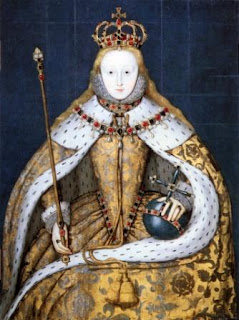 |
| The Coronation Portrait of Queen Elizabeth I. Image public domain through Creative Commons licensing, NPG, London. |
The Coronation Portrait of Queen Elizabeth I, now in the collection of National Portrait Gallery, was painted somewhere around 1600, copied after a now-lost original. Elizabeth I succeeded to the throne of England in 1558 and was crowned in 1559 at the age of twenty-six. In addition to the official coronation portrait, there are several miniature versions, including one attributed to Levina Teerlinc.
 |
| A miniature version of The Coronation Portrait of Queen Elizabeth I. Picture acquired through Wikimedia Commons. Image public domain. |
Unlike most Tudor and Elizabethan portraits, Queen Elizabeth I is depicted full-face in The Coronation Portrait; this is because the coinage and royal seals for the new regime were to be based off of this image. Her hair hangs loose about her shoulders, as was typical for a queen at her coronation. Elizabeth's heavy coronation robes are decorated with Tudor roses and fleur-de-lis. The fleur-de-lis, which is the heraldic emblem of France, represents the longstanding English claim to the French throne. According to the National Portrait Gallery, these elaborate robes were not custom-made for Queen Elizabeth, but were reused from the coronation of her sister, Queen Mary I just five years before, when England still had possession of its last French territory, Calais. Mary lost Calais in the final year of her reign.
 |
| A detail from a portrait of Queen Mary I. By Anthonis Mor, 1554. Picture acquired through Wikimedia Commons. Image public domain. |
Queen Elizabeth I's cloak is trimmed in ermine, the fur that sumptuary law dictated was only to be worn by royalty. This is one of the reasons why Alison Weir and other historians have questioned the attribution of the portrait known as Mary Boleyn, as the sitter is wearing ermine, and Mary Boleyn was not of royal birth.
 |
| The identity of this portrait is in question, due in part to the sitter wearing a robe trimmed with ermine. Picture acquired through Wikimedia Commons. Image public domain. |
In addition to projecting royal majesty in her portrait, Queen Elizabeth also embodies the standards of 16th century beauty. Queen Elizabeth is pale, as only people who had to work outdoors for a living had significant color in their skin. Elizabeth also has an unnaturally high hairline; she and other well-bred women plucked their hairlines to make their faces appear longer and thinner. Queen Elizabeth I would exaggerate these features as she aged in an effort to appear more youthful.
 |
| A detail of The Coronation Portrait of Queen Elizabeth I. Image public domain through Creative Commons licensing, NPG, London. |
Sources:
Gittings, Clare. Portraits of Queen Elizabeth. London: National Portrait Gallery Publications, 2003.
Print.
Weir, Alison. Mary Boleyn: The Mistress of Kings. New York: Ballantine Books, 2011. Print.
